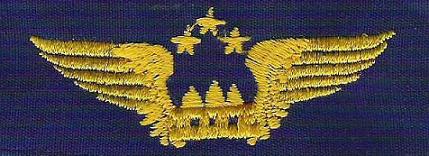 |
| Home | AVRK | AVNK | KAF | Links |

L'Armée de l'Air Khmère
Khmer Air Force
1971 The Khmer Air Force
On
8 June 1971, the military aviation became totally independent from the
Army. This last one did not plan any more its needs in terms of number
aircraft for a specific task but more simply by stating its requests
for transport or close air support. It was now the KAF that allocated
its units and aircraft according its own available resources and
according its centralized operation procedures. All the personnel
posting requirements now also belonged exclusively to the KAF command
staff. (see additional notes)
This
new branch of the armed forces is now a well recognized institution.
Not only for the defence of the country against foreign aggression, but
also as a tool to defend the institutions of the Republic. For during these troublesome times, Cambodia was not spared of political intrigues.
Immediately after the establishment of the KAF, another airbase was created at Ream, near the Port of Kompong Som. Its commander was Lt Col Pal Sam Or. In addition to serve as a base for maritime surveillance tasks, the airfield was mainly built with the idea to be a withdrawal place if Pochentong had to be evacuated. An important quantity of ammunitions, fuel and food supplies were stored there from the beginning. If the Communist shifted their offensive toward Phnom Penh, a prized objective, then we must evacuate the Pochentong Airbase; detailed plans were then prepared accordingly. At first signs of military crumbles on the Phnom Penh Front, part of the families of the Air Force personnel had to be evacuated towards Kompong Som. The Commander of the KAF Security Troops, Major Sou Chorn, had planned to leave the base at the last moment. Even if he had to suffer serious casualties, he conjectured that with a good air cover, he could withdraw with his men by road transportation. It was hope that the converging communist troops would not interfere with "fleeing enemy", concentrating instead on the capture of the city. Like many military plans elaborated on history, this one at the end could not be implemented.
Some
months later, two other airbases were created: Kompong Chnang under the
command of Lt Col Sok Sambaur and Kompong Cham, with Lt Col Mao Kim
Soun at his head. This last one operated mainly for the protection of
the fluvial convoys on the Mekong River. The increasing number of
operational T-28s, AC-47s and gunship helicopters meant now that the
security of the Mekong’s convoys up to Phnom Penh was handed over to
the KAF. Kompong Cham would also served as a jumping point for a
counter-offensive to retake Kratie, a town fallen into enemy hands
since the beginning of the conflict.
Among the other projects, but not on a priority basis, the Oudong landing strip
was proposed as an alternative as a civilian airport for Phnom Penh,
freeing Pochentong for military operations on a later stage. At the end
of the year Lon Nol gave a go ahead for preliminary studies carried out
by the KAF.
With the increasing number of sorties flown by the USAF as well as the VNAF over Cambodia it was necessary to coordinate the concerted allied air operations. Then it was decided to set up, in June 1971, an Air Operation Control Center (AOCC). Lt Col Norodom Baley, trained in 1963 in tactical air control with NATO at Baden Oss in Germany in 1963, was naturally chosen to direct the new centre. In fact, the AOCC became the main command centre for directing the KAF operations, as well as the coordinating body with the other allied air forces. The set up of the AOCC arrived in due time to oversee the launching a great offensive by the Army, Operation Chenla II, that started on 20 August 1971. Right from the start, the KAF was mobilized to support the ground units, notably by flying them into the targeted areas by helicopters. The T-28s and C-47s supported by their strikes and air drops the advance of the 5th Brigade that succeeded to retake Taing Krasaing at the end of September. The USAF played a key role by flying close air support missions that helped in the recapture of Barai near Kampong Thmar. At Phnom Santuk the advance encountered a vicious resistance leading to hands to hands fighting with our troops, making close support very difficult. Several Army battalions were finally isolated in the rubber trees plantation of Chamcar Andong, while several other brigades were forced back towards Taing Kaug and Treal. Despite numerous sorties to cover the withdrawing columns, we could not halt the North Vietnamese pursuing forces. All the counter-attacks to stabilize the situation failed with heavy casualties. All the helicopters were mobilized to support and evacuate the disorganized friendly forces. Chenla II had "sunk" ("leak teuk" in Khmer).
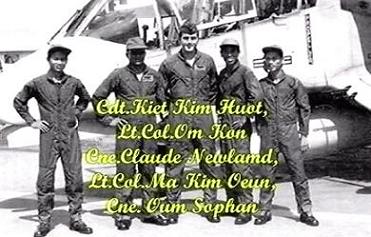 |
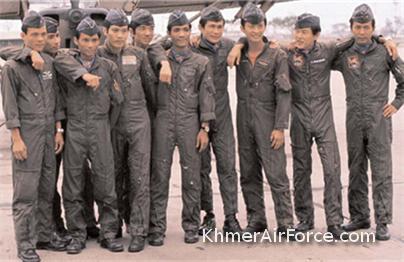 |
||
| The KAF also dispatched pilots to Bien Hoa, South Vietnam, and Udorn, Thailand, to fly with the USAF “Rustic” FAC. Our pilots’ knowledge of the local conditions helped them in their navigations and furthermore could contact directly the ground troops that did not speak English. Some mechanics also joined the program and served as translators aboard the US aircraft. |
|
Some pilots were also sent to American fighter units for operations in Cambodia. There, Ma Kim Oeun was shot down again but this time it was with an American teammate. Both were able to eject in parachute. They were rescued. These missions also prepared the Khmer pilots to receive American fighter jets in the future. At that time, no date was fixed and no aircraft type was chosen yet.
The
lack of a sufficient number of pilots with the KAF led to requesting
help from several friendly countries. In October 1971, our Chief of
Staff succeeded in his effort and obtained the dispatch of seven highly
experienced instructors from Taiwan.
Six of them were permanently affected to the Air Academy at Battambang.
They adopted a low profile and wore KAF uniforms. They allowed the
released of experienced Cambodian instructors for operational units.
Others requests were made with other anticommunist countries, but it
was not always with successes…
In
addition to the airborne FACs, we developed the Forward Air Guide (FAG)
program, with qualified observers in directing air support attached
with ground units. By the end of 1971, already some 200 NCOs had been
trained and attached, by groups of threes, to different Army units.
1972
On 5 January, Australia offered six C-47 transports. Discussions also took place to accept Khmer air cadets in the Australian military flying schools.
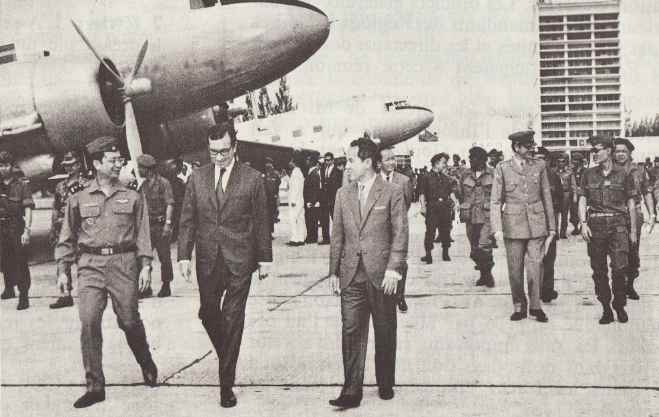 Voir autres photos... |
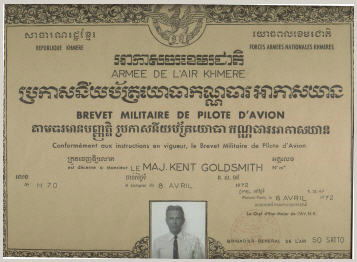 Major Kent Goldsmith....KAF Military Pilot License |
1972
Class Nine
Continuous air operations also resulted in increased losses. Around ten T-28s were then shot down by enemy ground fire. One of the most painful losses was LtCol Long Trasom, commander of the Helicopter Squadron; his UH-1H was brought down by a Strella Sa-7 missile at Svay Rieng.
The
newly graduated pilots, having got their "wings" after only an average
of 130 flight hours, were often immediately dispatched into operational
squadrons. There, they continued their "On job training". The most
experienced pilots in the units often brought them into their first
bombing or strafing courses by attacking real targets! Several of our
young pilots were killed due to lack of experience and several aircraft
were lost becaus of mechanical problems. In normal peacetime period, it
took us years of training and practices before a pilot could be
considered fully qualified for operations. But it was war time. After
an initial phase, trainings continued much like the World War II
process of the US Army Air Force. During World War II, in some training
centres, like for instance Harding at Baton Rouge,
Louisiana, up to one on eight cadets were killed before the end of
their training. It was the price of such accelerated syllabus.
|
Later on, the
situation improved as most of the cadets went to various American
training centres at Udorn, U Tapao or Takli in Thailand to attend
advanced and specialized trainings. Others went to train with the US
Navy at the Pensacola Air Station, Florida. A small number attended
courses in Australia.
|
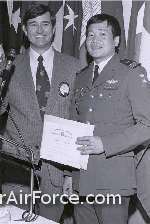 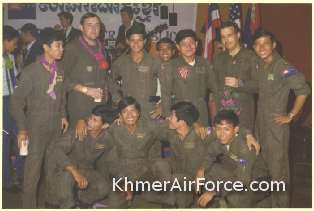 Major Suor and Pilots Class 8B et 9 with the US instructors. |
1973 Bombing of Presidential Palace
The
mechanics trained at Battambang and Pochentong were now operational. On
the overall in most fields the KAF was regularly improving its
operational level and a certain “cruising” speed reached, when suddenly
a disastrous event occurred on 17 March 1973.
Captain
So Potra was a suspended pilot. He stole a T-28 and dive-bombed the Presidential Palace. Then he flew
north towards the enemy occupied territories. Lon Nol was not present
during the attack. Four KAF officers belonging to the Royal Family were
arrested; the Lieutenant Colonels Norodom Baley and Nordodom Vatvani,
Major Dimang Rothary and Captain Oung Siphoun. They were detained and
interrogated by the G2 of the Army General Headquarters (The local
"Gestapo" directed by Lon Nol’s brother, Lon Non).
The
KAF commander, Brigadier General So Satto, resigned. He would
be posted as the Defense and Armed Forces Attaché at the Washington
Embassy. Colonel Penn Randa was appointed Brigadier General and became the commander and Chief of Staff of the KAF.
| Finding
nothing to culprit them, the arrested officers were released after two
months. Captain Uong Sipuon resumed his flying as fighter pilot while
Major Dimang Rothary was sent to Vientiane as the Air Attaché. Lt Col
Norodom Baley went to United States and served as a liaison officer
with the US Training Command; Lt Col Vatvani was posted to Udorn
Airbase in Thailand. (see the different posting in foreign countries). Some months later a new incident occurred; an O-1 FAC aircraft that went astray and over-fly by mistake the Presidential Palace was shot down by the local air defence unit. Later, several other aircraft were fired on when they neared the forbidden airspace, including civilian aircraft. |
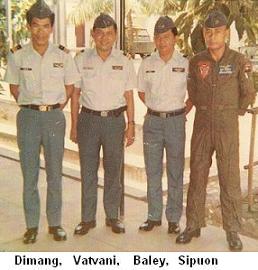 |
AU-24 Squadron
In March 1973, under the command of Major Tiem Keam
Suor, 86 pilots and mechanics went to Takli, Thailand, for a conversion
course on the AU-24 Helion Stallion...
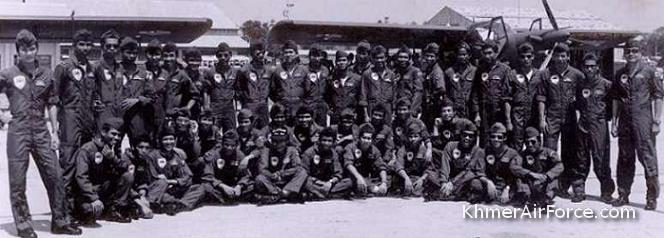 [names?] |
 More pictures on the team >>> |
1973 Attack of the Kampong Cham Airbase
At
the end of May the Viet Cong launched an all out offensive against
Kampong Cham and its airbase. This last one was the main focus of the
attacks, being the main and often the only remaining entry point to the
area. More than 50 KAF personnel were injured by the enemy mortar
shelling. The aircraft based there were flown back to Pochentong. The
base was defended by the KAF 2nd Defence Regiment which for ten days
was cut off and encircled. Thanks to a constant air support by the
fighters as well as the gunship helicopters, the defenders held and
repulsed any penetration attempts. When the enemy withdrawn, it left
over many casualties, including 25 bodies on the fences of the airbase;
our troops suffered 15 killed. During the counter-attack, the KAF
riflemen even retook a textile plant that served as a command post by
the communists. They even managed to re-open the route leading to the
town. The base commander, Col Meas Maroth, became the first KAF officer
to be awarded of the Sena Cheyset Medal, the highest Cambodian military
award.
| When
General Penn Randa took over as the new KAF commander, the United States
carried out their last troops withdrawal from South Vietnam, in
accordance with the “Face-saving” measures of the Paris Peace
Accords. On 15 August 1973, all US military operations must
be ceased in South East Asia; the KAF was now alone to prosecute the war.
However, the morale of its pilots remained high and they were
determined to carry on their missions. Some 700 combat sorties as well
as 100 transport missions were flown in August. The KAF strength and efficiency even bolstered during this period with the last minute delivery of new equipment; twelve additional T-28s; the first five C-123K Providers; six UH-1Gs; and a squadron-worth of AU-24s. If the number of sorties increased, the losses as well; we quickly lost three AU-24s. Then, a new disaster hit the KAF. photo transmis par D.Var
|
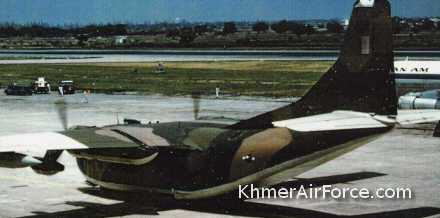 |
1973 Class Ten
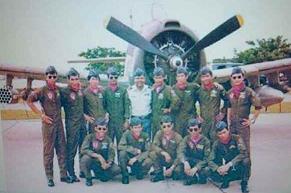
Some Cadets of Class 10 in advanced training with the USAF at Udorn
1973 Second bombing of Presidential Palace !
On 19 November, Lt Pech Lim Kuan, once more time, bombed the Presidential Palace! Brigadier General Penn Randa resigned. Brigadier General Ea Chong took his place, with Brigadier General Pao Lim Sina as his deputy. The Presidency now imposed that each fighter-bomber flight must be led by a "loyal" pilot. In case of doubt, he was ordered to shoot down his wingmen. Despite this deleterious climate, the KAF continued to made his duty by attacking the enemy
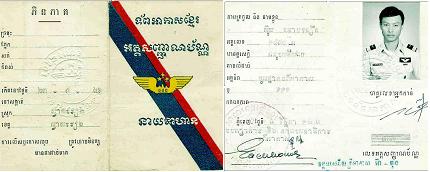 |
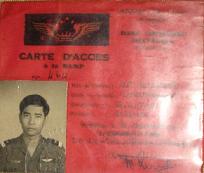 |
|
| An intact Identity Pass Card of the time, despite the eventful career of his owner, Cne Su Chhom Doeurn | Hao Sok Chantha (8B) | Kalmine Ly with an ID card in French |
1974
During the first days of 1974, the KAF flew up an average of 130 sorties per day. The precision of the air strikes of our young pilots had shown a considerable improving. For example, on a single mission, and precisely guided by an O1D FAC, the T-28s attacked a huge North Vietnamese motor park and destroyed over 100 trucks. It was the most successful strike of this kind of the entire war in South East Asia! After several years of nonstop missions, some of the young pilots even succeded in getting the instructor certificate. Our C-123 pilots, on their side, became real experts to sustain our ground units on the field. However, the KAF could not sustain this kind of operation on the long run due to budgetary cuts. The United States had dramatically reduced its military aid that was translated into a lowering of the stocks of available munitions. The living standards of our airmen began also to suffer accordingly. The military now were forced on both fighting the enemy and finding a living for themselves and their families.
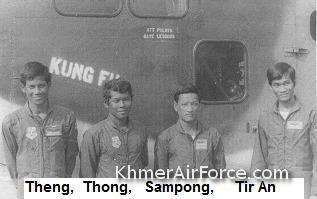 |
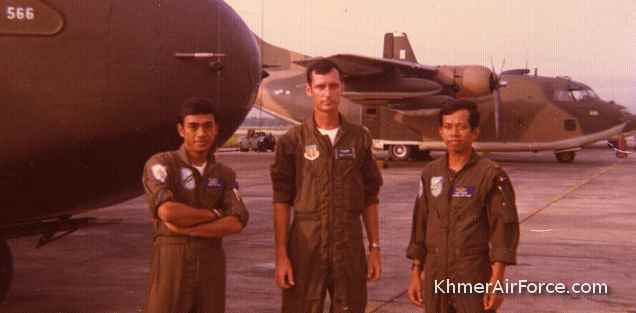 |
| Major Su Sampong and his crew of a C-123 | Rainsy - Philippe - Yuthan |
1974 Class Eleven
...
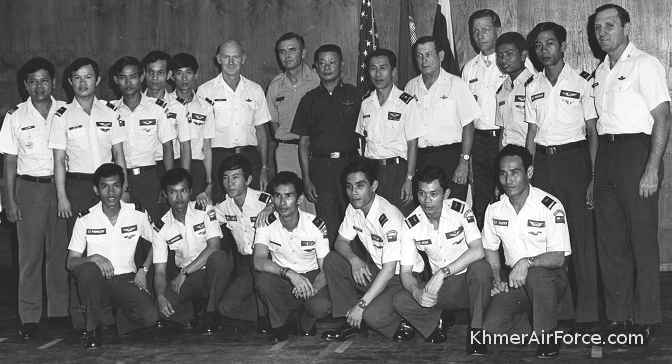
Last graduated pilots, last battles, with the last KAF Commander Ea Chhong.
The KAF Order of Battle in 1974 (According to A Grandolini)
|
Air Academy Intervention Group Observation Group |
Liaison and Transport Group 1 DC-6 |
According
to the MEDTC, as for 31 March 1975, the US delivered 309 aircraft. This
number does not include those delivered before 1970. A hundred were
lost. At periods, many aircraft were out of Cambodia supporting
trainings programs in USAF airbases in Thailand. During the war, in
addition to the aircraft readily available in the country, there were
also aircraft "on lease" stored in Thailand. These airframes allowed a
quick replenishment of the squadrons to replace their losses or to
bolster their strength at the place of machines send abroad for
maintenance and general overhaul. Among the twenty C-123s delivered,
several were transformed into bombers! The "B-123".
1975
The End
The Khmer Rouge now tightened the ring around Phnom Penh and at several occasions had neared from the Pochentong Airbase. The base was now repeatedly shelled by artillery and rocket firings. The operations there became more and more difficult. The returning aircraft were particularly targeted. Some pilots, like Lt Ros Saourn, were killed; his T-28D was hit by a mortar shell just after landing. Our C-47s and C-123s also continued their supply runs despite the enemy bombardments. Each of their movements was covered by our fighters which tried to silence the enemy artillery positions.
All
the fluvial convoys coming from the Mekong River were now suspended.
Washington urgently set up an air bridge, operating from Saigon. The
KAF had now the responsibility to protect the aircraft involved. Some
of the KAF security troops were also dropped by helicopters behind the
enemy lines to set up ambushes and trying to locate the artillery
batteries. Some of these dropped troops were unfortunately
decimated. Despite vicious fighting, our outposts were fallen one
after another.
See newsreel of French Public TV archives ww.ina.fr
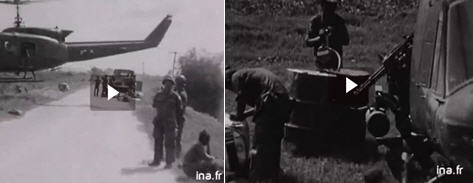 |
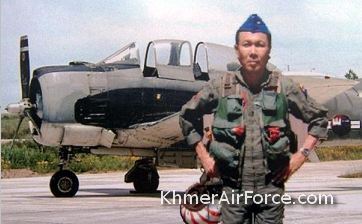 |
| Permanently
re-supplied by helicopters, the garrison of Neak Leung, on the bank of
the Mekong River, was one the last to fall before Phnom Penh. |
Om Vannac (Class 8B) |
On 12 April, the T-28s and UH-1s were mobilized to cover the evacuation of the US Embassy (Operation Eagle Pull). Even there was no hope left, the KAF planes continued the missions. Pochentong was under horrendous artillery shelling but at Phnom-Penh, another smaller airfield was also used. That same morning, a new government was formed. It sent a proposal to the Communists and Prince Sihanouk. The country was in a state of uncertainty. Some were exhausted and wanted to surrender while some others wanted to resist at any price. On 14 April, the young pilot Kiev Yoursawath bombed the Government Palace causing deaths and injuries.
On
the night of 16 to 17 April 1975, Lt
Col Tan Sam Hong was killed in a crash at Kompong Chnang. He was one
the last ranking officer to be brought down on operations. On the
morning of 17th, before dawn and with no response from the communists,
the government decided to resist from another point in the country. A
few hours later, Prince Sihanouk gave his answer. He rejected the
negociation proposal. It was too late to implement any evacuation plan.
The
Joint General Staff ordered the general surrender
of the Khmer Republic Armed Forces. Some of the government members
managed to escape to Thailand. At the KAF headquarters the white
flag had to be raised. The officers still present there were
immediately
arrested by the Communists. The bases and units commanders, left
leaderless, had now to act according to their own heart and soul.
When
the Khmer Rouge troops entered the Pochentong Airbase and occupied the
control centre, the last T-28s dropped their bombs on the buildings and
hangars before departing for Thailand. The aircraft that were en route
to a strike mission, or returning from a night sortie, found the base
occupied and could not land. They, too, flew out to Thailand. In this
exodus, around 100 aircrafts from various bases elected to seek asylum
in Thailand.
The airmen at the Kompong Cham airbase
continued the fight despite the capitulation order. Running out of
ammunition, the defenders were overwhelmed. The base commander and his
deputy were captured and executed in a gruesome manner. The fate of
their men was also terrible.
It
was the end of the Khmer Air Force; A young air arm that was forced to
grow quickly, in the heat of the battle, acquired experiences and
efficiency, before disappearing brutally. It was furthermore the end of
any seriously organized and efficient military aviation in Cambodia.
Twenty years of hopes, dedication and knowledge are gone forever.
Those
who had just been graduated in foreign schools could not return to
their beloved country. Those who survived tried to find a new future in
exile.
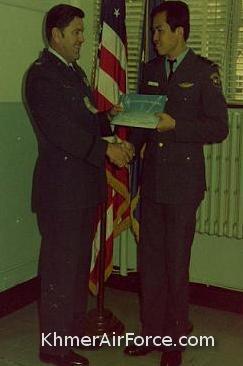 Lt Sam Bunny (Harrisson Lee) graduated from Denver AFB in 1975 |
|
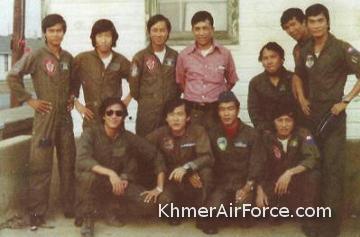 Standing> 2/Lt Pev Horn (Fighter 10), Capt Houl Channarith (Helico 8A), Capt Sunheng Ourk (Fighter 8A), LtCol Lim Kimkhun, Lt Om Vannac (Fighter 8B), Capt Te Tir An (AU24-C123, 8A) > 2/Lt Kim Kuong (Helico), Khy Peak Kuang (O1, 8B), Capt Ngorn (U24), Capt Oum Victhou (O1, 7), Capt Su Chhom Doeurn (Fighter 8A) |
We had lost the war. Cambodia had lost its freedom. Terrible events would come.
* * * * * * * * * *
These fragments of history are destined to the young generations. We hope they help to honour the memory of the officers and pilots, non commissioned officers and privates, who had sacrificed their lives to defend our fatherland, democracy and freedom. May the fallen rest in peace, their remembrances are engraved in our hearts.
How could we win the war, we, a small poor nation, with ill-equipped armed forces, when the Greatest Power on earth, with the most powerful and most advanced air force had failed in Vietnam. It was not a consolation but only a sad acknowledgement.
During
the war, some left-leaning journalists had deformed the facts and
questioned the willingness of the Khmers to assume their
responsibilities to carry the burden of these bitter combats.
Throughout the conflict, the Western public opinion, particularly in
the United States, went against us. Under this constant pressure, the
American policy makers renounced and withdraw their support. In the
end, the fact that new battlefields opened deep inside Cambodia served
well the US policy of the moment. These new fronts fixed a part of the
North Vietnamese forces, allowing the United States to continue to
withdraw its troops from South Vietnam. After supporting our struggle, Washington progressively withheld its aid.
We were a sacrified gizmo on the play-game of the International politic.
The
Communists beneficed from a support more powerful than weapons: the
western media. These last ones put under light any mistakes or
misdemeanours done by our troops. On the other side, voluntarily or
not, they subdued any exactions or terror actions, particularly those
of the Khmer Rouges, carried out by the Communists. Some show business
celebrities, notably famous pop singers, openly supported the communist
side. Some of them presented their regrets after the war. For the Khmer
People it was too late.
REFLECTIONS
An
organized and trained air force could reduce the gap between small and
powerful nations. It is a dissuading factor that entrusted mutual
respect between neighbours. It is an element that could bring
peace and stability. Within a nation, an Air Force could not seized
power. Instead, it could contribute to control or impede any
adventurous moves by ambitious military commanders.
Aviation
is also a space of dreams on the border of freedom, rigour and
discipline. It set an example for many youths. It is a driving
development force for a country, bringing new knowledge on the fields
of science and technology, new industrial capacities and modern
transportation means. For Cambodia, aviation today could even be a
source of income by developing its airlines to transport its peoples
and foreign tourists.
May the new generation renew with our aviation past and set a new example of success in our sky.
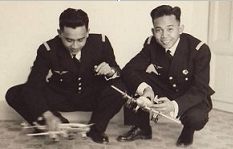 |
|
| Satto et Baley Salon de Provence, 1955 - 1958 |

